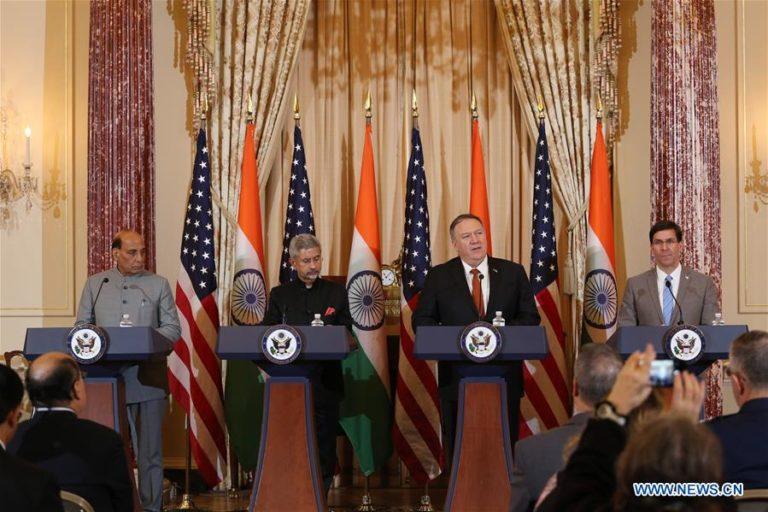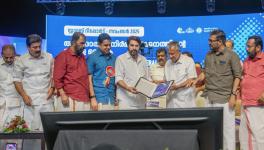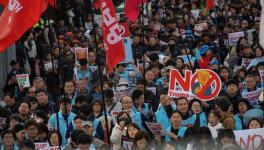US-India: Why 2+2 May Not Always be 4

US Secretary of State Mike Pompeo (2nd R, Rear), U.S. Secretary of Defense Mark Esper (1st R, Rear), Indian External Affairs Minister S. Jaishankar (2nd L, Rear), Indian Defense Minister Rajnath Singh (1st L, Rear) attended a press conference following th
To what extent External Affairs Minister S. Jaishankar’s cancellation at the last minute of the scheduled meeting on Thursday with a Congressional panel in Washington, DC, was with an eye on Nagpur one doesn’t know. He is an ambitious media savvy politician with an IQ by far higher than of anyone else in Prime Minister Modi’s cabinet.
What can be deduced at this point is that the Jayapal distraction drew attention away from the outcome of the 2+2 foreign and defence ministers meeting in Washington on December 18. The US-Indian military-to-military ties are deepening and the two countries are tiptoeing toward a veritable alliance in the Indo-Pacific region.
The US side is plainly delighted that with Jaishankar’s return to the foreign policy-making echelons as EAM in May, the unclogging of the arteries of US-Indian partnership began in right earnest. Jaishankar is also uniquely placed to influence the decisions of the Indian defence ministry, although Raksha Mantri Rajnath Singh is a towering presence with a booming voice and notionally one of the senior most politicians in the BJP. Plainly put, Jaishankar calls the shots since he knows how to work the system — and it is no secret that he enjoys Modi’s trust and RSS’ patronage.
The 2+2 in Washington conveys the impression that the US-Indian strategic partnership is preparing for an exciting journey ahead. The silence on the part of the US officials with regard to Citizenship Amendment Act or the lockdown in Jammu & Kashmir needs to be understood in this light. (More of that later.)
In geopolitical terms, the 2+2 has been principally about the Trump administration’s Indo-Pacific strategy. The climate of tensions between the US and China provided its backdrop. This is a historic juncture when the US is in great need of an alliance with India to strengthen its hands in the fierce struggle with China in the Asian theatre.
There is consensus in the Beltway that China is America’s number one rival, and most analysts in the US and abroad estimate that a high-stakes struggle between the two great powers lies ahead for the foreseeable future.
It means that India can rest assured that the current trend of hostile American moves against China across a broad spectrum ranging from trade and technology to currency and Hong Kong and Xinjiang will only accelerate for at least a decade to come. The lack of consistency in American policies toward China prompted India in the past to hedge and pause.
Taken together, therefore, the Indian establishment estimates that the time has come to signal to the US its readiness to shed strategic ambivalence and to stand up and be counted as a close, trusted partner in Washington’s Indo-Pacific strategy to tackle China’s rise. The outcome of the 2+2 suggests that India has pressed the ‘play’ button.
The joint statement issued after the 2+2 talks shows a remarkable congruence in the two countries’ approach to the rise of China. The India-US-Japan trilateral format and the Quadrilateral (‘Quad’) format are being groomed for creating a quasi-alliance system to step up practical cooperation in areas ranging from infrastructure development, cyber security, counterterrorism, and regional connectivity to ‘capacity-building of peacekeepers’ and maritime security.
The US and India are envisaging a “comprehensive, enduring, and mutually-beneficial” partnership within which they have resolved to “expand all aspects of their security and defence cooperation.” Some of the major templates are:
- upgrade of the ‘tri-service’ military exercises to sophisticated level (which will now also include Special Forces) with accent on ‘interoperability’;
- enhanced cooperation between the Indian armed forces and the US’s Pacific Command, Indo-Pacific Command and Africa Command;
- assignment of an Indian officer to liaise with the US Central Command Hqs. in Doha;
- strengthening of joint and service-to-service interaction and cooperation between Special Operations Forces;
- “capacity-building efforts” in the Indo-Pacific;
- signing of the Industrial Security Annex last week, which will facilitate exchange of classified military information between the two countries’ defence industries;
- defence innovation cooperation and linking of India to the US-led global defence supply chain;
- finalisation of a Statement of Intent to co-develop “several projects”;
- collaboration on testing and certification in defence and aerospace sectors and establishment of Maintenance Repair and Overhaul facilities in India;
- convergence on cyber security cooperation, particularly in regard of 5G networks; and,
- potential defence cooperation in the domain of space.
State secretary Mike Pompeo said at a joint press conference with the visiting Indian ministers that with the signing of the Industrial Security Annex, “we have almost finished all of the enabling agreements that will allow us to have the maximum level of collaboration and cooperation with India, both in sales as well as coproduction.”
But he also added a caveat: “And so at a certain point in time, there is a strategic choice that needs to be made about platforms and systems, and our – certainly, we are encouraging India to look at our platforms and our systems as the most efficacious as it’s facing challenges in the Indo-Pacific region.”
Plainly put, US expects India to turn to American vendors as the principal source of weaponry. Pompeo hinted unmistakably that everything hangs on India paring down its defence relationship with Russia. Pompeo was frank: “India is very well aware of the concerns we have both over – our concerns related to Russia and… our concerns over our ability to achieve the interoperability that we seek with India.”
The 2+2 in Washington is an important milestone in US-Indian strategic partnership and there’s going to be far-reaching consequences. China will watch the development with alarm. What form or directions the Chinese reaction will take lies in the realm of the ‘known unknown’.
Again, India has appeased the Russians so far by awarding lucrative arms deals, but bazaar instincts work only up to a point in the new Cold War conditions. The US-Russian relations are deteriorating. It’s a matter of time before Washington insists on India to make its choice — ‘You’re with us, or against us’.
The US sanctions against Turkey, a key NATO ally, on account of its S-400 missile deal with Russia, or, against German companies involved in the Nord Stream 2 gas pipeline project with Russia are signposts.
On Friday, Trump signed the defence spending bill for 2010 that includes several measures aimed at punishing Turkey. The legislation shuts out Turkey from NATO’s F-35 fighter jet program and punishes Turkey further by lifting a US arms embargo on its Eastern Mediterranean adversary Cyprus, and slapping sanctions on shipping companies involved in the construction of the Turkstream gas pipeline project with Russia.
On December 18, the US Senate Foreign Relations Committee overwhelmingly voted to approve a “comprehensive, bipartisan bill (which) significantly increases the political, diplomatic, and economic pressure on the Russian Federation in response to its malign activities around the world.” One of the sponsors of the proposed legislation, Senator Lindsey Graham (Republican-South Carolina) calls the legislation “sanctions bill from hell”.
In the very same week, US Congress passed yet another legislation, The Eastern Mediterranean Security and Energy Partnership Act, whose main thrust is to diversify Europe’s energy sources away from Kremlin-controlled companies.
In such a context, Moscow will be watching the 2+2 in Washington with growing disquiet. A commentary in the Kremlin-funded RT on December 19, titled New Delhi, beware of Americans bearing gifts and promises! warned India explicitly against entrapment in the US’ regional strategy. At any rate, can India afford to overlook the crucial Russian support in the UN Security Council in the time of troubles?
Indeed, can India overlook that the US stance on core issues — Pakistan, Kashmir — lacks bite only because it is muted? Turn up the volume a few decibels and it becomes clear that the US never explicitly supported India’s crackdown in J&K or condoned the CAA. In fact, the US federal commission on religious freedom has demanded sanctions against Home Minister Amit Shah.
The noted India hand, Prof. Paul Staniland at the University of Chicago wrote in a recent essay entitled India’s New Security Order, “I identify three characteristics of the new (Modi-Jaishankar) order: an emphasis on risk-taking and assertiveness, the fusing of domestic and international politics, and the use of unrelenting spin to hold critics at bay.”
“This approach carries potential benefits for the United States in bolstering its position in Asia. But it also brings a set of risks and challenges that demand clear-eyed analysis — and a willingness to debate how the United States engages with India moving forward.”
The US stance is highly ambivalent and everything devolves upon India’s utility for the US’ geo-strategies. At the 2+2 meeting last week, India shed its coyness and signalled a willingness for the first time to play at the high table of global politics. The shift is in consonance with Jaishankar’s facile notions such as that India’s past record shows that “a low-risk foreign policy is only likely to produce limited rewards.”
How does one define “low-risk foreign policy”? Pray, when Indira Gandhi split Pakistan by half, ignoring (and defying) world opinion, was it a “low-risk” affair? Besides, in the contemporary world situation, it isn’t in India’s hands alone to formulate that definition. Professor Staniland notes,
“What does this new dynamic mean for the United States? Washington has reasons to want a more assertive and powerful India as a counterweight to Chinese influence… An India that is serious about overcoming the negative trends in its military balance with China, establishes linkages to American allies and partners in Asia and beyond, pursues liberal democratic values, and continues high levels of economic growth would be a serious asset. This bundle of opportunities has driven Washington towards increasing Indian-American alignment since the early 2000s.”
Doesn’t the actual Indian capability play a part in all this? Jaishankar’s obsessive belief that India is a key player in an emerging multipolar order is born out of sheer naïveté. Realistically speaking, the danger today lies in getting locked into the US’ containment strategy against China. It is apparent that in the period since Jaishankar’s appointment as EAM, India’s relations with China have become unpredictable, as evident from the latest meeting of the special representatives of the two countries in Delhi on December 20, as is borne out by the Indian and Chinese readouts (here and here).
On the other hand, the US cannot be unaware of India’s actual military power relative to China — leave alone its comprehensive national power, which includes the economic performance. The trend lines are hopelessly negative for India and the capability gap vis-a-vis China can only worsen further in the period ahead.
The economy is, in the final analysis, the central driver of India’s strategic clout and fudging economic data can no longer hide the bitter truth that the economy has entered an alarming slump. Modi’s talk about a $5 trillion economy in a near future draws only derisive laughter from economists in India and abroad.
Added to all that are the faultiness that have surged thanks to the BJP’s domestic political project of relegating the Indian Muslims as second class citizens, which in turn creates international challenges.
Meanwhile, Modi’s open embrace of Trump at the Houston rally in September and the direct and vituperative attack on Congresswoman Pramila Jayapal and other leading Democratic Party figures are manifestations of a dangerous gambit to wade into the American political system.
Herein lies the paradox. The vista of high-profile security and military cooperation that the 2+2 envisages becomes unsustainable if it runs parallel with the severe erosion of the democratic values and shared values that constituted an important pillar of American support for India.
There is strident criticism in the mainstream US opinion that Modi is inexorably moving India in the direction of ‘illiberal democracy’. The Modi government is seen as part of a transnational wave of illiberalism. Delhi’s knee-jerk reaction is to resort to the hackneyed methods of lobbying and diaspora mobilisation. But times have changed.
What the Jayapal episode highlight is that the bipartisan political pillar of the US-Indian relationship in America has become wobbly and a patch-up via transactional realpolitik will not work. One of the fallouts of the great schism that developed in American politics following Trump’s election as president in 2016 has been that one half of America rejects everything that he stands for, which in turn has led to a new willingness to revisit the American strategy.
One main reason why Turkey and Saudi Arabia, two close allies of the US historically, are taking such flak today in the US Congress is because of the perception in the Beltway that Trump is warm towards them. This is where Jaishankar has made a mistake by insulting Jayapal. The Modi Bhakts have only made matters worse by charging like hyperactive Rottweilers at Senator Elizabeth Warren and other Democrats who came to Jayapal’s rescue.
Get the latest reports & analysis with people's perspective on Protests, movements & deep analytical videos, discussions of the current affairs in your Telegram app. Subscribe to NewsClick's Telegram channel & get Real-Time updates on stories, as they get published on our website.























